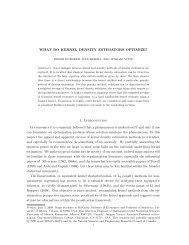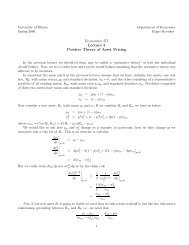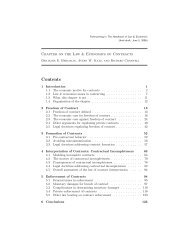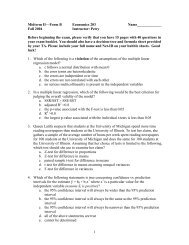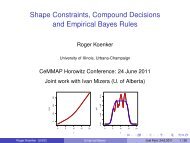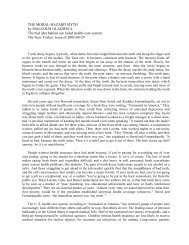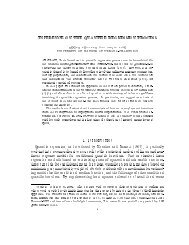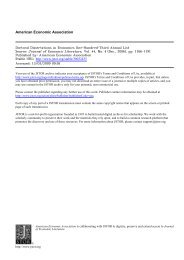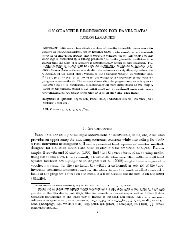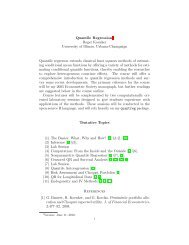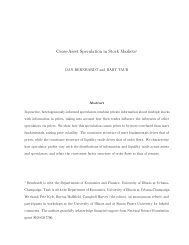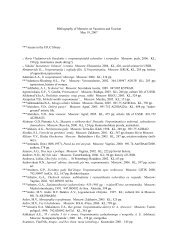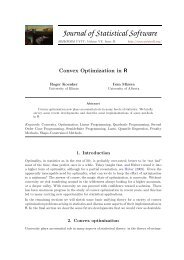1 Static Classical and Keynesian Models: A Comparison
1 Static Classical and Keynesian Models: A Comparison
1 Static Classical and Keynesian Models: A Comparison
- No tags were found...
Create successful ePaper yourself
Turn your PDF publications into a flip-book with our unique Google optimized e-Paper software.
Suppose that M goes up. What happens?1. Nothing happens to the equilibrium real wage rate, (W=P) ? .2. Nothing happens the aggregate output y ? .3. Aggregate dem<strong>and</strong> goes up. Therefore, P ? goes up.4. IS-curve stays put. On the other h<strong>and</strong>, when M goes upLM-curve shifts right <strong>and</strong> when P ? goes up LM-curve shiftsleft. Recall that y ? doesn't change. Therefore, these shiftsmust cancel each other. LM-curve stays put <strong>and</strong> nothinghappens to r ? .5. Finally, nothing happens to c ? <strong>and</strong> i ? .Money Is Neutral!
1.2 The <strong>Keynesian</strong> Aggregate Supply Function In <strong>Keynesian</strong> model we assume that wages are sticky|due to,for example, long-term nominal wage contracts. Therefore, in astatic <strong>Keynesian</strong> model we treat W as if it was exogenous to themodel: W = W: Therefore, the supply of labor n D <strong>and</strong> the dem<strong>and</strong> for labor n Sneed not be equal. The dierence between the two (n S ; n D ) iscalled (involuntary) unemployment. Hence, the labor market equilibrium consists of four equations:f 0 (n D ) = W Pn S = hW = Wn = n D : WPThat is, the labor market wage rate is above its (exible-price)equilibrium wage rate <strong>and</strong> hence there is excess supply of labor.
1.3 The <strong>Keynesian</strong> Model To summarize, we just derived the following relations determiningthe <strong>Keynesian</strong> system:y = C(y ; ) + I(y r)+g (9)M= L(y r)P(10)y = Given these variables, equationsdetermine c <strong>and</strong> i, respectively. MP g (11)y = (P W ) (12)y = f(n) (13)f 0 (n) = W P : (14)c = C(y ; ) (15)i = I(y r) (16) We regard the variables W , M, g, <strong>and</strong> to be exogenous|therst one predetermined <strong>and</strong> the rest are set by the government.Hence, we have a system of six equations in four unknown endogenousvariables: y, r, n, <strong>and</strong> P . [Note: the aggregate dem<strong>and</strong>function (11) is redundant as it was derived from the IS (9)<strong>and</strong> LM (10) curves, <strong>and</strong> (12) is redundant as it was derived fromthe production function (13) <strong>and</strong> labor market (14) equations.]
The order of determination is as follows.1. Given the exogenous variables, intersection of the AS (12)<strong>and</strong> AD (11) curves determines the equilibrium output y ?<strong>and</strong> price level P ? .2. Intersection of IS (9) <strong>and</strong> LM (10) curves determines theequilibrium interest rate r ? .3. Dem<strong>and</strong> for labor (14) determines the equilibrium employmentn ? . Suppose that goes up. What happens?1. Aggregate dem<strong>and</strong> goes down <strong>and</strong> hence equilibrium pricelevel P ? <strong>and</strong> output y ? go down.2. IS-curve shifts left <strong>and</strong> LM-curve shifts right. Therefore, theequilibrium interest rate r ? goes down.3. Since y ? <strong>and</strong> P ? go down, n ? goes down.4. Finally, c ? goes down. The eect on i ? is ambigious.
Suppose that M goes up. What happens?1. Aggregate dem<strong>and</strong> goes up. Therefore, P ? <strong>and</strong> y ? go up.2. IS-curve stays put. On the other h<strong>and</strong>, when M goes upLM-curve shifts right <strong>and</strong> when P ? goes up LM-curve shiftsleft. However, since y ? goes up the former eect dominates.r ? goes down.3. Since y ? <strong>and</strong> P ? go up, n ? goes up.4. Finally, c ? <strong>and</strong> i ? go up.Money Is NOT Neutral!
1.4 Conclusions1. The classical <strong>and</strong> <strong>Keynesian</strong> model have dierent predictionsconcerning the eectiveness of the scal <strong>and</strong> (especially) monetarypolicy. Which one is more realistic is subject to ongoingdebate.2. The results depend crucially on the assumption that the capitalstock is xed. One could argue that this is not such big issuewhen dealing with the monetary policy.3. The results depend crucially on the assumption that the pricelevel changes (ination/deation) doesn't aect the interest rate.This is not an innocuous assumption when dealing with the monetarypolicy. Hence, next week we will move to the dynamicmodels <strong>and</strong> relationship between ination <strong>and</strong> interest rates.



